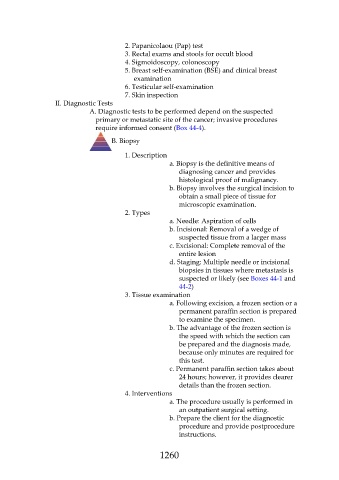Page 1260 - Saunders Comprehensive Review For NCLEX-RN
P. 1260
2. Papanicolaou (Pap) test
3. Rectal exams and stools for occult blood
4. Sigmoidoscopy, colonoscopy
5. Breast self-examination (BSE) and clinical breast
examination
6. Testicular self-examination
7. Skin inspection
II. Diagnostic Tests
A. Diagnostic tests to be performed depend on the suspected
primary or metastatic site of the cancer; invasive procedures
require informed consent (Box 44-4).
B. Biopsy
1. Description
a. Biopsy is the definitive means of
diagnosing cancer and provides
histological proof of malignancy.
b. Biopsy involves the surgical incision to
obtain a small piece of tissue for
microscopic examination.
2. Types
a. Needle: Aspiration of cells
b. Incisional: Removal of a wedge of
suspected tissue from a larger mass
c. Excisional: Complete removal of the
entire lesion
d. Staging: Multiple needle or incisional
biopsies in tissues where metastasis is
suspected or likely (see Boxes 44-1 and
44-2)
3. Tissue examination
a. Following excision, a frozen section or a
permanent paraffin section is prepared
to examine the specimen.
b. The advantage of the frozen section is
the speed with which the section can
be prepared and the diagnosis made,
because only minutes are required for
this test.
c. Permanent paraffin section takes about
24 hours; however, it provides clearer
details than the frozen section.
4. Interventions
a. The procedure usually is performed in
an outpatient surgical setting.
b. Prepare the client for the diagnostic
procedure and provide postprocedure
instructions.
1260

